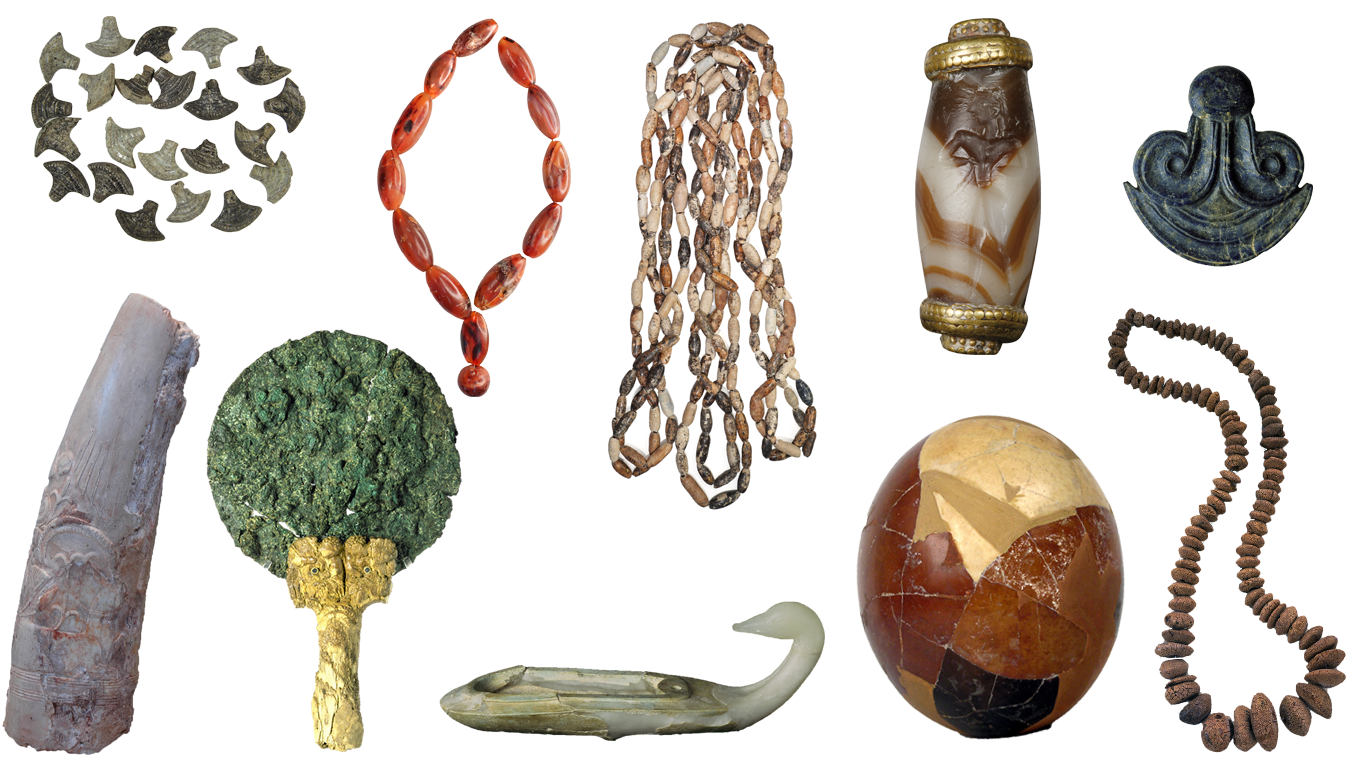Exhibit of the month
Exotica from the ends of the earth…
National Archaeological Museum
Collection of Prehistoric, Egyptian, Cypriot and Near Eastern Antiquities, inv. nos P 2446, 2523, 2667, 2916, 2839, 2898, 2916, 6298, 6433, 9506.
Provenance: Acropolis of Mycenae, Tholos tombs of Mycenae
Date: Late Helladic IIIA-B (14th-13th c. BC)
Display location: Collection of Prehistoric Antiquities, Room 4, Showcases 30, 36.
In the 16th century BC, the Mycenaeans, a warlike people with commercial acumen, emerged on the international stage and would dominate the Aegean for the next four centuries. With their ships, they crossed the Eastern Mediterranean, established trading stations on Cyprus, Syria and Egypt, whilst in search for gold, tin and other precious metals, they reached Southern Italy and Sicily to the west, Spain, Britain and Cornwall to the north.
A plethora of semi-precious stones, such as amethyst, carnelian, rock crystal, jasper, agate, serpentine, malachite and lapis lazuli were imported into the Mycenaean centres from Syria and West Asia through Egypt and were used for the manufacture of sealstones and impressive, colourful necklaces. Apart from gold, the Mycenaeans also imported from Egypt glass in the form of discoid ingots, but also ready-made beads of blue and green faience [εικόνα 5], in a wide range of shapes. Elephant and hippopotamus ivory came from Africa and India through Syria, to be transformed, in the skilful hands of the Mycenaean craftsmen, into inlays for wooden furniture and luxurious objects like mirrors, jewellery boxes, combs and pins.
Other exotic materials, such as electron (amber), resin produced from the petrified pine forests, mainly of the Baltic Sea, and ostrich eggs from Egypt and the Near East shaped into ritual vases (rhyta), were exchanged as diplomatic gifts among the rulers of the Eastern Mediterranean. The discovery of two shipwrecks off the south coast of Asia Minor, of Uluburun (late 14th c. BC) and Cape Celidonia (ca. 1200 BC), offers the most eloquent testimony on the sea trade of the Late Bronze Age (17th-12th c. BC) across the Eastern Mediterranean. Apart from fruits, herbs and spices that were transferred on the cargo of Uluburun —many of which are recorded in the Mycenaean Linear B script, such as pomegranate, sunflower seed, coriander, cumin and sesame— the ship traded mainly ingots of copper, tin and glass, timber, luxurious pottery and vases filled with scented wine.
Dr E. Konstantinidi-Syvridi
Bibliography:
Caubet, A., Ivory, Shell and Bone, in Aruz, Bendel, Evans (eds.) Beyond Babylon. Art, Trade and Diplomacy in the Second Millennium BC, The Metropolitan Museumof Art, New York 2009.
Nightingale, G., Tiny, fragile, common, precious. Mycenaean glass and faience beads and other objects, in Jackson, C., E.C. Wager, Vitreous materials in the Late Bronze Age Aegean: A Window to the East Mediterranean World, Oxbow Books, London 2008.
Pulak, K., The Uluburun Shipwreck and Late Bronze Age Trade, in J. Aruz, K. Benzel & J. Evans (eds). 2008. Beyond Babylon: Art, Trade and Diplomacy in the 2nd millennium BC. The Metropolitan Museum of Art, New York, Yale University Press, New Haven and London 2009: 289-310.
Xenaki-Sakellariou, Α., Οι Θαλαμωτοί Τάφοι των Μυκηνών, Ανασκαφής Χρ. Τσούντα (1887-1898), Paris 1985.


